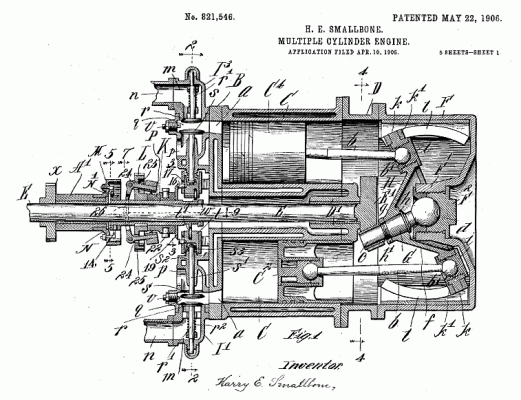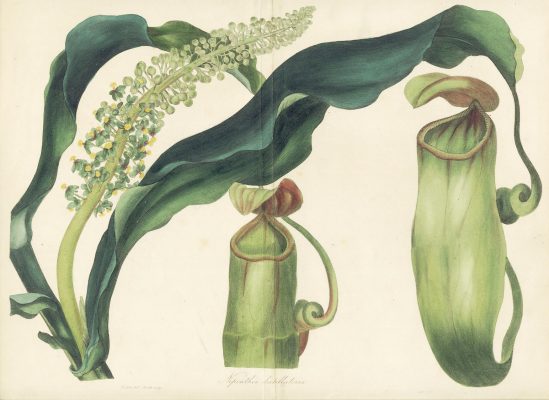In simple terms, the process of combustion creates energy that is converted into motion. The ignition by the spark plug of the admixture of fuel and compressed air forces the piston down. This energy is used to rotate the propeller shaft that runs the length of the vehicle to the differential which shifts the power ninety degrees, turning the rear axle which in turn turns the wheels. Back in the engine, the crankshaft, via the connecting rod, brings the piston up again for another intake of air and fuel, allowing the process to be repeated. It is repeated hundreds of times per minute. This is the four-stroke combustion cycle, the invention of Nikolaus Otto. Otto was a German inventor. He grew up on a farm in the Rhineland-Pfalz region and served an apprenticeship in commerce. He abandoned his career in business in order to pursue his interest in gas engine design. It is a common misconception that Otto received the Grand Prix at the International Exposition of 1867 in Paris for his four stroke engine. It is true that Otto and his partner Eugen Langen were indeed awarded the Grand Prix by Napoleon III at the 1867 International Exposition, and that the Exposition was in Paris, but it was for the earlier atmospheric gas engine that ignited fuel without compressed air. Among the many who visited the Exposition was Jules Verne, who drew some of the inspiration for 20,000 Leagues Under the Sea from the demonstrations of electricity on display there. Perhaps if Otto had invented his four stroke engine in time for the International Exposition of 1867 in Paris it might have captured Verne’s imagination instead, though it is possible that cross-country driving may not have held the same mystique for readers of nineteenth-century science fiction as underwater travel. Nevertheless, Otto’s machine was impressive for its time and Verne would have been at least mildly interested, if not as taken with it as Napoleon III.
Though more efficient than the Otto and Langen engine, itself an improvement on Étienne Lenoir’s 1858 design, the early versions of the Otto Silent Engine, as the four stroke engine was called, was still not perfect. Its innovative design could nevertheless have secured Grand Prix at the third Paris World’s Fair in 1878, but Germany was not represented, having perhaps been left off the invitation in the wake of the Franco-Prussian War, in which France had lost Alsace-Lorraine and Napoleon III had been captured. At any rate, its competition that year would have included Alexander Graham Bell’s telephone and Thomas Edison’s phonograph. The head of the Statue of Liberty and other completed pieces were also on display and may well have overshadowed the Otto Silent Engine, particularly given the flaws that were yet to be corrected. For instance, only approximately ten per cent of the fuel used in the engine was employed in actually moving the vehicle. The remainder was wasted, merely producing heat. Hoping to find a more efficient solution, Rudolf Diesel, a German engineer, developed the diesel engine between 1892 and 1897, basing it upon an alternative principle in which the fuel was injected into the cylinder after the air had already been compressed, causing it to ignite due to the heat created by the compression itself. While the cleaner, quieter four stroke engine remained the preferred engine for automobiles, the greatly increased efficiency of the diesel engine led to its adoption in the manufacture of trucks, trains, boats, cranes, tractors, and buses. This bus has a diesel engine.
Regardless of the type of engine, a vehicle’s acceleration is achieved in much the same way, that is, by the workings of the transmission, which is made up essentially of an input shaft coming from the engine, an output shaft connected eventually to the drive wheels, and the gears themselves, moving back and forth to connect input and output. These are broad strokes. The apparatus is more complicated in practice. Also, this is only the case for a manual transmission. This bus has a manual transmission.
Using a manual transmission and assuming the road surface has a gradient of roughly zero and assuming the bus is fully laden with passengers, it would take slightly less than twenty seconds for the bus to reach a speed of twenty-four miles per hour. It is travelling at twenty-four miles per hour.
In addition to the four stroke cycle, Nikolaus Otto also invented the first low voltage magnetic ignition. He regarded this achievement as the completion of his life’s work. In 1886, however, a German court invalidated his patent rights. The decision sent Otto into a deep depression that contributed to his premature death.
The basic mechanism of a braking system involves first a pivot to multiply the force of a foot on the brake pedal. The depression of the pedal pushes the brake fluid from the pedal cylinder to the brake cylinder. The larger size of the brake cylinder relative to the pedal cylinder multiplies the force again. This force causes the caliper to tighten the brake pads against the rotor, resulting in the friction that slows the disc down. This is the case for hydraulic brakes. Air brakes function slightly differently, relying on compressed air rather than brake fluid. It is primarily the increased reliability of air brakes that makes them preferable for use in heavy vehicles. A bus such as this one weighs up to eighteen tonnes with a full load of passengers, making reliable brakes an important design consideration. The air brakes on this bus function adequately.
After suffering a catastrophic defeat and capture at the Battle of Sedan in 1870, thereby losing the Franco-Prussian War, Napoleon III spent the remainder of his life in exile in England, living in the stately Camden Place in Chiselhurst, not far from London. The house is currently the Chiselhurst Golf Club, though Napoleon III was not responsible for its conversion, which took place much later. He died there on 9 January 1873 from complications during surgery to remove a bladder stone. His opinions regarding the game of golf or the idea of turning his house and grounds into a venue for playing it remain a mystery. At the time of his death, he may have been looking forward to reading Jules Verne’s Around the World in Eighty Days but would not have had the opportunity. The book was not published until 30 January. If he ever read Jules Verne at all, it is possible that he may not have had much interest in reading towards the end of his life, as he was haunted by his catastrophic defeat at the Battle of Sedan and the loss of the Franco-Prussian War. He confused the doctor attending him for a soldier. Like Nikolaus Otto, Napoleon III was depressed, though not in the same way as a brake pedal.
Once the brake pedal is depressed and the brakes pads are applied, the pressure of the brake pads on the rotor requires time to convert the kinetic energy of the wheels into heat, during which time the vehicle remains in motion. The distance needed in order to stop any moving body depends on a number of factors. These include the velocity of the body, the mass of the body, and the coefficient of friction between the body and the surface it is travelling on. The lighter and slower the body, the less the stopping distance. For instance, a woman running and waving her arms in the air might weigh around one hundred pounds and be moving at a rate of fourteen miles per hour. Assuming she is wearing sports shoes with average traction, she would require less than a yard to come to a stop. An empty child’s stroller weighing no more than fifteen pounds rolling backwards at perhaps three miles per hour would, even with bald tyres, have a stopping distance of only an inch or two, were its brakes to engage spontaneously. By contrast, a bus of eighteen tonnes travelling at twenty-four miles per hour would require in the vicinity of seventy feet to reach a complete stop. These calculations would all change if the road conditions were wet. The road is not wet.
In 1913, after leaving Antwerp, a crewmember of the post office steamer Dresden entered the cabin of a passenger who had asked to be woken at a quarter past six. The cabin was empty and the passenger could not be found on board the ship. The cabin belonged to Rudolf Diesel. Ten days later, a body too badly decomposed to be recognisable was pulled from the North Sea off the Norwegian coast. The possessions found on the body were ultimately identified as belonging to Rudolf Diesel. It was later revealed that Diesel had been on the verge of bankruptcy. Nikolaus Otto’s son, Gustav, followed in his father’s footsteps, founding the Bayrische Autogarage Company that would eventually merge with the Rapp Motorenwerke Company to form Bayrische Motoren Werke, or BMW. He followed in Rudolf Diesel’s footprints, too. His business troubles caused him to commit suicide in 1926.
The calculation of the stopping distance of a vehicle must also take into account the reaction time of the driver, that is, the distance the vehicle travels in the time between the moment the imperative to stop becomes apparent to the driver and the moment the driver is able to slow the vehicle by the application of pressure to the brake pedal. Reaction time varies from person to person and can depend on many factors. Driver alertness and alcohol consumption typically make the biggest difference but even assuming a blood alcohol level of zero and an average level of alertness, a calculation of a driver’s reaction time must allow for the driver to detect the presence of an obstacle, to recognise the obstacle as an obstacle, to understand that he must take some action to avoid a collision, and to mentally programme the movement that will perform that action. After that, the actual movement must be performed, which may involve turning the steering wheel and lifting the foot from the accelerator and pressing it down onto the brake pedal. Finally, the brakes require time to engage, though only a fraction of a second. The total usually estimated for this whole elapse of time is one and a half seconds. The velocity at which the vehicle is traveling during those one and a half seconds can translate into a considerable distance that must be added to the overall stopping distance without applying the formula for calculating deceleration. If a vehicle is travelling at twenty-four miles per hour, a reaction time, or more properly, a reaction distance of about thirty feet would need to be added to the overall stopping distance. For an eighteen tonne bus travelling at this speed, the total stopping distance would be close to one hundred feet. The bus, given its limited manoeuvrability, would be unlikely to be able to avoid any obstacle in its trajectory within that space.
In certain circumstances, something that has been seen or experienced may not be accessible to the conscious mind of the person who saw or experienced it. The brain has means at its disposal to protect the psyche. Received visual stimulus too traumatic to contemplate can be erased or altered in the memory. An unthinkable image may be substituted for something else. I saw a brilliant white flash bounce against my windscreen.
In 1886, Jules Verne was shot twice by his nephew, Gaston. To be precise, Gaston shot him twice in succession, as opposed to shooting him on two separate occasions. Jules Verne was not fatally wounded. Though left with a limp, he otherwise made a full recovery. He went on to write a further twenty-five novels. In 1888, he stood for and was elected town counsellor for Amiens and served in that position for fifteen years. He died at home in 1905 of diabetes-related illness with his wife and son by his side. The house is now the Jules Verne Museum. It is not a golf club.
This story was on the shortlist for The White Review Short Story Prize 2013.




